
Enlarge / SpaceX’s Falcon Heavy rocket stands on Launch Complex 39A in Florida, hours before its scheduled liftoff with the military’s X-37B spaceplane.
Trevor Mahlmann/Ars Technica
CAPE CANAVERAL, Florida—A SpaceX Falcon Heavy rocket is poised for launch as soon as Tuesday night from the Kennedy Space Center in Florida, and the US military’s mysterious X-37B spaceplane is fastened atop the heavy-lifter for a ride into orbit.
Although the Space Force is keeping details about the military spaceplane’s flight under wraps, we know it’s heading into an unusual orbit, probably significantly higher than the X-37B’s previous sojourns that stayed within a few hundred miles of Earth’s surface.
SpaceX’s launch team called off a launch attempt Monday night “due to a ground side issue” and reset for another launch opportunity as soon as Tuesday night at 8: 14pm EST (01: 14 UTC). When it lifts off, the Falcon Heavy will light 27 kerosene-fueled engines to power the rocket off its launch pad overlooking the Atlantic coastline.
You can watch the launch using SpaceX’s live video feed on X, the social media platform, or if you prefer YouTube, third-party streams are available from Spaceflight Now and NASASpaceflight.
The exact altitude the X-37B will be flying through is unclear, but hobbyists and amateur sleuths who use open source information to reconstruct trajectories of top-secret military spacecraft suggest the Falcon Heavy will haul the winged vehicle into an orbit that could stretch tens of thousands of miles above the planet.
What’s more, the Falcon Heavy will apparently take a flight path toward the northeast from Florida’s Space Coast, then ultimately release the X-37B on a trajectory that will take it over Earth’s polar regions. This is a significant departure from the flight profile for the military spaceplane’s six previous missions, which all flew to space on smaller rockets than the Falcon Heavy.
In a statement, the Space Force said this flight of the X-37B is focused on “a wide range of test and experimentation objectives.” Flying in “new orbital regimes” is among the test objectives, military officials said.
“It seems to me like it might be a much higher orbit that it’s going to,” said Brian Weeden, director of program planning for the Secure World Foundation, which promotes sustainable and peaceful uses of outer space. “Otherwise, I don’t know why they would use a Falcon Heavy, which is a pretty big thing.”
Covering more ground
The X-37B spaceplane has attracted a lot of attention and speculation since its first mission in 2010. Across multiple administrations, Pentagon officials have consistently walked a narrow line between acknowledging the existence of the spaceplane, and divulging limited information about its general purpose, while treating some details with the utmost secrecy. The military does not talk about where in space it flies. With a few exceptions, defense officials haven’t publicly discussed specifics of what the X-37B carries into orbit.
The military has two Boeing-built X-37B spaceplanes, or Orbital Test Vehicles, in its inventory. They are reusable and designed to launch inside the payload fairing of a conventional rocket, spend multiple years in space with the use of solar power, and then return to Earth for a landing on a three-mile-long runway, either at Vandenberg Space Force Base in California or at NASA’s Kennedy Space Center in Florida.
It resembles a miniature version of NASA’s retired space shuttle orbiter, with wings, deployable landing gear, and black thermal protection tiles to shield its belly from the scorching heat of reentry. It measures 29 feet (about 9 meters) long, roughly a quarter of the length of NASA’s space shuttle, and it doesn’t carry astronauts. The X-37B has a cargo bay inside the fuselage for payloads, with doors that open after launch and close before landing.
The Space Force made a surprise announcement on November 8 that the next flight of the X-37B, sometimes called OTV-7, would launch on a SpaceX Falcon Heavy rocket. All six of the spaceplane’s past flights launched on smaller rockets, either United Launch Alliance’s Atlas V or SpaceX’s Falcon 9.